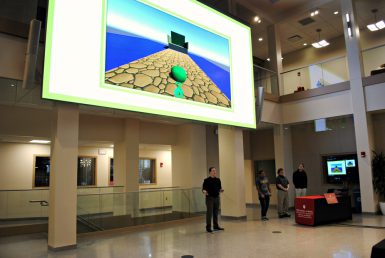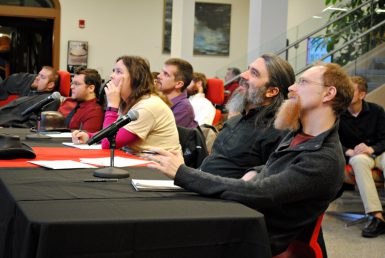Game design students pitch games for development greenlight

Students in Game Workshop II pitched their game ideas to a tough crowd of panelists Friday night in an event that had much more on the line than an end-of-the semester class presentation.
“It’s what we effectively call the shark tank,” said Mike Sellers, game design professor of practice who introduced pitch night to a small crowd in Franklin Hall commons. “This is is no longer a project for a grade. This is the first part of your career.”
That “first part” consists of showing a prototype game to a panel of game design professionals in hopes that your product will get a thumbs up. The ideas were hatched in Game Design II/Production II, where teams of students developed prototypes. In Workshop II, they develop and test the games, then present at pitch night to determine what games are suitable to move on to Game Workshop III, where they refine, publish and market their games. Upon graduation, students have a completed game in their portfolios.
Sellers, who worked in game production for two decades, helped recruit judges, who included Daniel Cook, chief creative officer at Spry Fox, a game development company; Jason VandenBerghe, creative director at Ubisoft; Lisa Brown, independent game developer and game designer in residence at Harrisburg University; and Tim Fowers, video and board game designer.
Students demonstrated their work on the big screen in the commons. First was the team from From Within, where the goal is to rescue aliens on other planets from extinction and collect artifacts so their culture does not die. Then, once the species are collected, the player takes them onto a spaceship and builds a “biome specific room” for each creature in order to gain trust and learn new things about the universe.
Gaia’s Guardian features Gaia, a wolf guardian of the sprit world. Players see two different worlds – the spirit world and the real world – and can switch between them freely in order to solve puzzles and eventually defeat the antagonist, The Corruption.

Skate Squad is a first-person action game in which the player’s character is riding rollerblades around a course and trying to defeat a given “boss” or enemy specific to the level. The whole thing is set up like a game show, with a Producer who acts as a friend and encourages the player to keep doing better, and an omniscient Narrator who the player cannot see but is announcing all of the action of the game in real time.
Slime is a game in which the player is a ball of slime rolling around the world and trying to get around obstacles. As the ball rolls, it loses mass, so the trick is to not lose all of the ball’s mass by the end of each level. The ultimate goal of the game is to collect as many “shiny things” as possible and become the next Slime King.
In Tori, the player is a bird flying around otokai or “land of sound” in Japanese. The goal is to collect sounds that are stored throughout the world in everything from rocks to chimes to fish. After players have collected a sound or group of sounds they like, they can drop them in a nest and then listen to the sounds all together, like an orchestra. The designers stressed there is no wrong or right way to play this game. This is meant to be a meditative game where the player decides how they would like to interact with this world.
War Tent is the opposite. Players must control their armies to defeat the enemy. The player must relay commands to commanders, who then relay those commands to various pawns who have their own personalities. Players first select who they want in their armies, then they hold a strategic meeting, then the battle commences and, finally, the “carnage report” comes in and that’s the end of the round.
The final game presented was Witch of the Woods. Here, the player is a witch who has awoken from a long slumber and found that the world around her is not in balance anymore. The goal of the game is to put the ecosystems around you back into order using spells and magic. First, the witch glances into her crystal ball and decides what she wants to fix. Then, she finds a recipe for a spell to help fix the problem. The witch then has to travel the area in order to find all of the ingredients for the spell. Finally, she has to decide where she wants to cast the spell (location matters in this game).

After each presentation. the members of the panel gave their feedback and made suggestions for how to better the games.
“They looked at our games through an experienced lens,” said Joseph Adams, a member of the Tori team. “They were able to find design problems in five minutes that would have taken us a year to figure out.”
After some deliberation, the panel, along with a few of the professors in the game design program who have been working closely with each of the teams, will decide what games will go on to the next step of production and which won’t.
Because of this, there was a little bit of a competitive feel to the night.
“There’s always a competitive edge in this program,” said another Tori member, Joshua Smith. “But we still all work with each other regularly, so we want everyone to succeed. We’re all excited for each other.”
This is a good philosophy, because in spring semester’s Game Workshop III class, some teams will be reconfigured based on which games get a green light, and the students move on to refine, publish and market only those games

